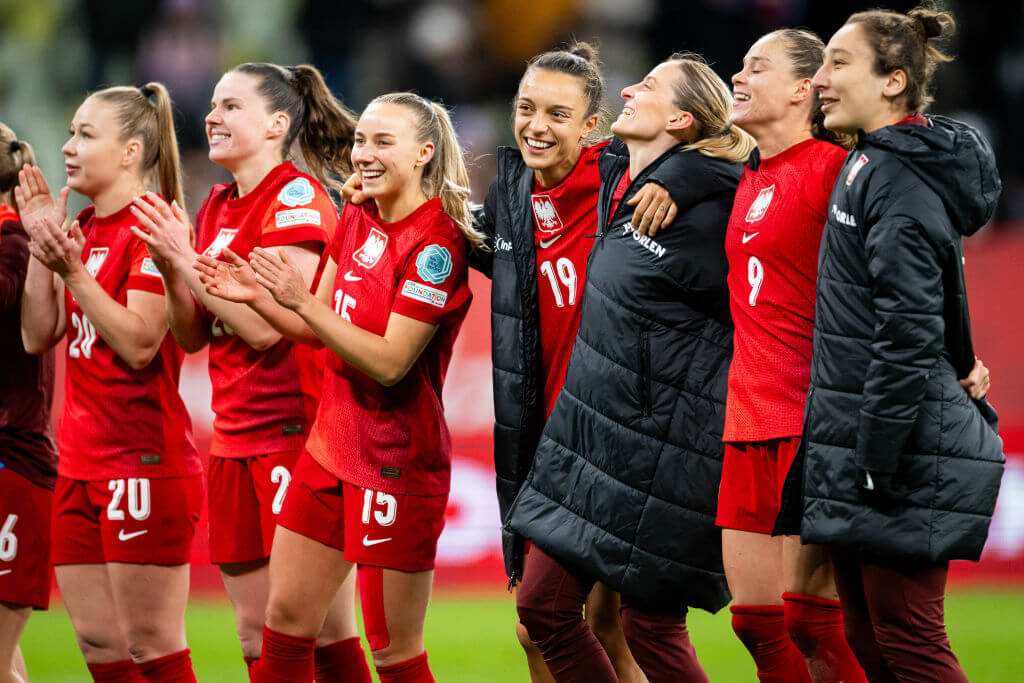
The geographical pattern is stark: besides Poland, every other side are from western or northern Europe. The Poles’ qualification, as one of two new debutants alongside Wales, represents the Women’s European Championship extending its reach eastwards.
Handed a tough draw, Poland will struggle to get out of Group C, despite being able to count on arguably the competition’s best striker in Barcelona’s Ewa Pajor. But their participation in the tournament alone is a great success: they did not win any of their eight matches in the Euro 2005 qualifiers.
Who is the manager?
Nina Patalon has the classic story of injury forcing early retirement, allowing the former player to get stuck into coaching.
A Poland Under-19 international two decades ago, Patalon played only until she was 25. Then, after a short spell in club coaching, she joined the Polish federation in 2011, initially working with the women’s under-15 side, before moving up through the age groups and becoming the national team coach in 2021, the first female to take the top job.
In many ways, her journey feels similar to that of Christian Wuck, the German manager she will encounter in both sides’ first group game.
How do they play?
Against weaker opposition, Poland have the technical quality to dominate — the attacking patterns of play they showed in their recent Nations League campaign were fluid and effective. But considering they start with matches against Germany and Sweden, two genuine contenders in this tournament, it seems likely they will use a cautious, counter-attacking 4-5-1 system.
Their winner in the first leg of their qualifying play-off against Austria is the template. It featured Ewelina Kamczyk bursting forward on the break from midfield, then Pajor and Natalia Padilla running in behind to combine.
Who are their three most influential players?
A handy underdog combination of a reliable striker, a counter-attacking winger and a solid goalkeeper.
Pajor, who is also their captain, has won the top goalscorer award in the German and Spanish top flights in the past two seasons — more on her later. Her main goalscoring support comes primarily from speedy, two-footed winger Padilla, who was also eligible to represent Spain, Morocco and the United States through various family members’ heritage, and comes into the tournament after a good season on loan at Sevilla from Bayern Munich.
At the other end of the pitch, the Polish men’s team are renowned for producing a disproportionate number of top-class goalkeepers, and their women have a reliable one, too. Kinga Szemik had a productive four years playing in France before moving to West Ham United, and performed well in her debut WSL campaign during 2024-25. She is likely to be one of the busiest goalkeepers in the group stage.
What is their biggest strength?
Put simply, it’s Pajor, who has scored 50 more international goals than anyone else in this squad, and got 43 in 46 games for Barcelona last season. She is capable of making good runs in behind a defence — which will be a major factor in this tournament when Poland play on the break — and thrives off crosses, generally after a sudden burst to nip ahead of an opponent and a first-time finish.
The obvious question is how often Pajor manages to actually touch the ball inside the other team’s box at Euro 2025. But, up against a weak-looking German back line, do not rule out her tournament starting with a goal.
What weakness might other teams be able to exploit?
Poland played Bosnia & Herzegovina twice in April in the Nations League and conceded a near-identical goal in both games, being opened up by a through ball played inside left-back Martyna Wiankowska. They have also conceded several set-piece goals over the past year.
Any notable absentees?
Poland appear to have avoided any major injury problems, and given the excitement about their first qualification for a major tournament, there was never much chance of any unexpected international retirements.
What is their strongest starting XI?
How have they performed over the past 12 months?
Poland finished bottom of their qualifying group, behind Germany, Iceland and Austria, losing all six matches with a -13 goal difference. But then, in the play-offs late last year, they comfortably defeated Romania, before facing the Austrians again. Clearly, Austria were favourites, having recorded two 3-1 wins against them in the group, but Poland produced brilliant tactical displays to win both matches 1-0.
Their six games in 2025 have been against weaker opposition from the Nations League’s second tier, but they are unbeaten in them, meaning Poland have won nine and drawn one of their past 10 matches going back to last July.
The challenge awaiting them in Switzerland will be much tougher, but they are in good form.
What are they expected to achieve at these Euros?
Losing four of their six group-stage qualifiers to sides who are also at this tournament does not bode well. Had Poland been drawn in Group A, you would give them an outside chance of progressing to the knockout phase, but in Group C, a single win — probably from their third and final game against Denmark — would be considered an excellent return.
Really, for Poland, this tournament is about building for the future and promoting women’s football back in their homeland.
Did you know?
Poland had hoped to stage this tournament, but their bid came third behind Switzerland and a combined effort from Sweden, Denmark, Norway and Finland. They are trying again for 2029, with the host nation set to be announced in December.
This article originally appeared in The Athletic.
Poland, UK Women’s Football, Women’s Euros
2025 The Athletic Media Company
